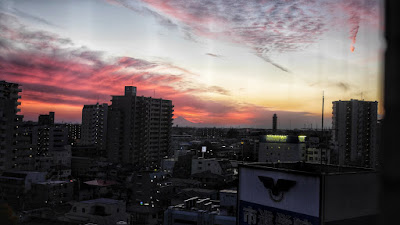Don’t Rattle Your 忍者刀 Ninjatō
From Bujinkan Santa Monica by Michael
 |
| Mt Fuji all the way from Kashiwa, photo by Michael Glenn |
I try to prepare for these lessons, yet I am still surprised. I suppose the only way is to always be ready. This is the ukemi of being Hatsumi Sensei’s student.
I landed at Narita Airport around 5pm local time. My normal plan is to run through immigration and customs as fast as Japanese bureaucracy will allow. Then catch a two hour train ride straight to Hatsumi Sensei’s class.
One hour into the train ride I began to lose my motivation. Warm trains make me sleepy. That, and the 20 hours of travel that wasn’t over yet.
I stood up to shake off the tired. It was already dark out, and the train cabin was reflected back to us in the window. I leaned my head against the door to watch the lights pass outside.
It looked wet and miserable out. I already felt the cold when I transferred at the last station. But when my eyes adjusted to the dark I couldn’t believe what I saw between the railroad ties. Patches of snow flashed by like a flickering reel of film!
It was only November. Snow in Tokyo is extremely rare this time of year. I already had two shirts on, and now I pulled a hoodie over those.
The old Atago station was dark and quiet. My breath fogged. A patch of snow crunched under my boot. During my walk to the dojo I wondered if class was cancelled.
I came around the corner and I could see the lights were on. I marveled at the snow on the rooftop. I slid open the door… Konbanwa!
A warm crowd inside and many old friends greeted me. I changed quickly into my gi. Was I ready? I don’t know, at least I was there.
Hatsumi Sensei taught at an intense pace. He started off class at the highest levels of training. It was all about letting go and 空間利用 kukan riyō, using the kukan.
The train passed by and shook the building.
"Hai, OK!" Soke called out. Then he started with the 忍者刀 Ninjatō and I paid close attention. Someya Sensei cut in at him...
Hatsumi Sensei was in 棟水之構 Tōsui no Kamae. He lifted his blade softly as if to shield against the katana. Someya tried to cut again. Soke let his sword slip and then smacked it into Someya’s neck without cutting.
He told us one of the themes this year was 一刀万方 Ittō Banpō, which is one sword, many possibilities. It may also be written 一刀万宝 Ittō Banpō which means one sword, many treasures.
There are many treasures in the study of the Ninja-tō. Hatsumi Sensei wrote
忍者の剣は、闇夜の剣を避けがたしThis can be read many ways. One interpretation is that “the sword of the ninja doesn’t rattle in the dark of the night”. In other words, avoid rattling your sword.
What does that mean beyond being stealthy? Lucky for us Hatsumi Sensei has also shared this gokui in relation to the Ninja-to:
抜かず勝て、抜けば切るなよ、ただ忍べ、命をとるは大事とぞ知れWhen Hatsumi Sensei smacked the blade against Someya’s neck he was demonstrating this principle. He even told us that night that we were all too quick to use the sword. He said that when we tried to use the sword, we missed the kyojitsu.
Win without drawing the sword
if you draw it, don’t cut
Simply persevere
Know the significance
Of taking a life.
I hold onto these memories and lessons from Soke like treasures. During the first hour of my train ride (which you can watch part of here: Ninja True: How to get to the Bujinkan Honbu Dojo) I caught a glimpse of Mt Fuji in the distance. The slope of Fuji Sama seemed to hold the burnt sunset for every last bit of warmth.





